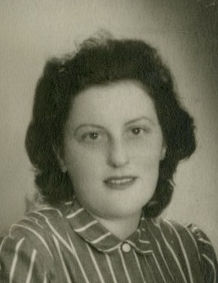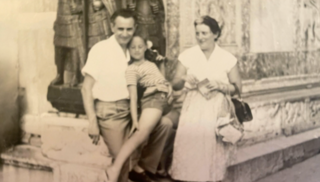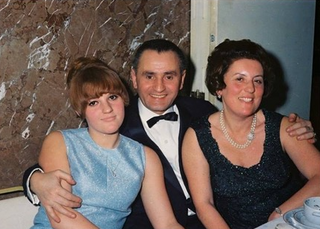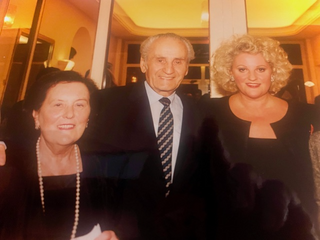Edith Esther Lichter (geb. Spivak)

Personalia
Born:
Died:
Profession:
Curriculum Vitae
Edith Esther Spivak was born in Osijek, Croatia, the legitimate daughter of opera singer Paul Spivak and his wife Maria, née Boskowitz. The Jewish family moved to Budapest, where her mother ran a piano store. Edith Esther attended elementary school there and then the Zrinyi Ilona Girls' Grammar School, where she graduated in 1937. She then enrolled in art history at the University of Budapest.
In 1939, Edith Spivak married the Hungarian Jew Pista Bokor. After Hungary entered the Second World War on June 26, 1941 on the side of the Axis powers, Pista Bokor was drafted and subsequently killed. The now war widow Edith Bokor remains behind in Budapest.
Jews in Hungary are exploited but persecuted under the dictatorship of Reich Governor Miklós Horthy.
After a phase of material exploitation under Miklós Kállay, Prime Minister under Reich Governor Miklós Horthy, the next phase of persecution in Hungary begins in 1944. Along with the German invasion troops, a 200-strong special task force of the Reich Security Main Office (RSHA) under the leadership of SS-Obersturmbannführer Adolf Eichmann arrived with the order to initiate the 'Final Solution' and to monitor its implementation by the Hungarian authorities. According to German estimates, around one million Jews were killed. The stages of the Final Solution to be carried out by the Hungarian authorities were registration, identification, deprivation of rights, ghettoization, forced labour, expropriation and deportation.
On 19 March 1944, Hungary was occupied by German troops under the code name 'Operation Margarethe'. On March 23, 1944, a new government is formed under Prime Minister Döme Sztójay. The Jewish Hungarians were soon completely disenfranchised with 107 laws.
Edith Bokor was taken prisoner by the German Wehrmacht and the SS Sondereinsatzkommando just one day after the occupation of Hungary. The ghettoization began on 16 April 1944; eleven days later, on 27 April 1944, the mass deportations to the Auschwitz concentration camp followed under the direction of Adolf Eichmann . The imprisonment in ghettos and camps is carried out by the Hungarian gendarmerie.
Edith Bokor is deported to the Ravensbrück concentration camp on November 15, 1944. From there, as the Red Army approached, she was transferred to the Salzwedel concentration camp on April 1, 1945, where she was liberated by the 9th US Army on April 8, 1945. After the traumatic and inhumane conditions in the concentration camps, her health was so poor that she was admitted to the Salzwedel district hospital on the day of her liberation, where she had to stay until July 22, 1945.
After her recovery, she returned to Budapest, where she met Naftuli Lichter, a Jew from Lviv [today: Lviv in Ukraine]. He had also survived the horrors of the Nazi concentration camps. They married in 1946.

On March 19, 1944, Hungary is occupied by German troops under the code name 'Operation Margarethe'. On March 23, 1944, a new government is formed under Prime Minister Döme Sztójay. The Jewish Hungarians were soon completely disenfranchised with 107 laws.
Edith Bokor was taken prisoner by the German Wehrmacht and the SS Sondereinsatzkommando just one day after the occupation of Hungary. The ghettoization began on 16 April 1944; eleven days later, on 27 April 1944, the mass deportations to the Auschwitz concentration camp followed under the direction of Adolf Eichmann . The imprisonment in ghettos and camps was carried out by the Hungarian gendarmerie.
After her recovery, she returned to Budapest, where she met Naftuli Lichter, a Jew from Lemberg [today: Lviv in Ukraine]. He had also survived the horrors of the Nazi concentration camps. They married in 1946.
After the Communist takeover in Hungary, the Jewish family had to flee and moved to Vienna. Edith and Naftuli Lichter, who later changed his first name to 'Ferdinand', initially considered emigrating to Israel or Australia, but then found their home in Vienna and stayed. On October 24, 1949, their daughter Marika Mirjam Rachel Lichter was born.

Edith Lichter later founded a small textile company in Vienna. She retired in the 1980s and died at the age of 84. She finds her final resting place at the Jewish Cemetery in Vienna.
Her daughter is the later famous singer, actress and music manager Marika Lichter. Performing on national and international stages and on television, Lichter is also known far beyond Austria's borders for her social commitment. With the play 'I have (no) homeland', she reworked the story of her parents. She explored the concepts of 'home' and 'home' as well as the experience of Jewish life. It consisted of a mixture of stories, quotes and songs, ranging from pop hits to arias and political songs, and addressed the feeling of being a foreigner.

Places
Residence:
Persecution:
Citations
Wiener Stadt- und Landesarchiv (WStLA)
Arolsen Archives
Marika Lichter, Privat
Wikipedia
